UCSB professor who helped create blue LEDs shares Nobel Prize
Reporting from Santa Barbara — A California scientist and two in Japan won the Nobel Prize in physics on Tuesday for a breakthrough invention that reduces global warming and brings light to areas of the world that are off the electrical grid.
Shuji Nakamura of UC Santa Barbara shares the prize with Isamu Akasaki and Hiroshi Amano for devising a blue light-emitting diode, a long-awaited missing link that in the 1990s paved the way for energy-efficient LED lighting.
Thanks to the work of the three scientists, environmentally friendly lighting is becoming ubiquitous in the developed world and is poised to spread to the 1.5 billion people around the globe without access to electricity, according to the Royal Swedish Academy of Sciences, which bestows the Nobel Prizes.
------------
FOR THE RECORD:
Nobel Prize in physics: In the Oct. 8 Section A, an article about the winners of the Nobel Prize in physics said that UC Santa Barbara is in Isla Vista. It is in an adjacent unincorporated part of Santa Barbara County.
------------
“This is very much in the mind of Alfred Nobel, who wanted to give his prize to the inventions for the benefit of mankind,” said Olle Inganas, an electronics expert and member of the academy.
Nakamura, a professor of materials and of electrical and computer engineering at the Isla Vista campus, said he was roused by the call from Sweden in the dark hours of Tuesday morning. Instead of going back to sleep, he got dressed and came straight to UCSB.
“I’m so excited,” he said during a news conference on campus, a wide grin spread across his face.
LED lights can last up to 25 times longer than the incandescent light bulbs popularized by Thomas Edison. They also use 75% to 80% less energy than the traditional bulbs, which lose about 90% of their energy to heat.
“It’s a great way to make an Easy Bake Oven, but it’s a lousy way to make a light,” Kevin Jones, a materials scientist at the University of Florida in Gainesville, said of incandescent lighting.
In January, the U.S. government began the final phase-out of incandescent light bulbs, which can no longer be manufactured in America because they don’t meet energy efficiency standards.
“Incandescent light bulbs lit the 20th century; the 21st century will be lit by LED lamps,” Nobel officials wrote in their announcement.
Akasaki said he had often been told that his research wouldn’t bear fruit in the 20th century.
“But I never felt that way,” said the scientist, who works at both Meijo University and Nagoya University in Japan. “I was just doing what I wanted to do.”
Light-emitting diodes, or LEDs, use semiconductors to generate light particles. The first diodes were created in the 1950s and 1960s at longer wavelengths of light — infrared and red. They were followed a few years later by the shorter wavelengths of yellow and green.
But the shortest visible wavelength, blue, proved elusive. And without blue to mix with red and green wavelengths, it was impossible to create white light.
Creating that blue diode was no easy task. It required a material that could be used in sandwiched layers of semiconductors to generate light from electricity.
Akasaki and Amano, who was Akasaki’s graduate student at Nagoya University, focused on a promising material called gallium nitride. But there were significant problems: The crystals grew very slowly, and the materials had to be extremely pure and free of physical imperfections.
Nakamura, then at Nichia Chemicals in Tokushima, Japan, was also working with gallium nitride — and reportedly unpopular among company managers, who said the scientist was spending money and not bringing results.
While other researchers abandoned gallium nitride and tried less persnickety materials, the Japanese researchers pressed on.
“They felt like the oddballs, talking about something nobody else was working on, so they were really out on their own there,” said Christian Wetzel, a physicist at the Rensselaer Polytechnic Institute in Troy, N.Y. “It took some character to not do what others were doing but keep [going] despite all the frustration.”
Eventually, the two teams each developed different methods for growing high-quality gallium nitride crystals.
Nakamura left Japan and joined UC Santa Barbara’s faculty in 2000. The next year, Nichia sued Nakamura for infringing on trade secrets. The scientist countersued, demanding more than the approximately $200 he had been paid for his invention. The two parties settled in 2005, with the company paying Nakamura $8.1 million.
Jones, who called the innovation revolutionary, said he attended a lecture about two decades ago where Nakamura switched on his LED. Jones recalled that he was nearly blinded by the dazzling blue.
“That was always the Holy Grail,” he said.
These lights use so little energy that they could potentially be powered by a book-sized solar panel stuck onto a roof, said physicist Fred Dylla, executive director of the American Institute of Physics. That could be especially useful for people in remote areas who live off the grid.
“It’s such a wonderful invention,” Dylla said. “It’s already out there being used and making people’s lives better.”
Indeed, LED lights are already proving instrumental in aiding education in parts of Africa by giving children a light source to study by at night, Jones said.
Nakamura said the lights are popular in developing countries, in part because they are inexpensive to operate. What’s more, he added, they don’t contribute to climate change.
“There’s no carbon dioxide emissions,” he said. “It will save resources. ... An LED light will last a lifetime, almost forever.”
Tresa Pollock, chair of the UCSB materials department, said many people had yet to grasp the significance of her colleague’s research on LEDs. “It’s huge,” she said.
Fellow Nobel laureate Herbert Kroemer, who retired from UCSB’s electrical and computer engineering department, came to campus Tuesday to celebrate his former colleague.
“It’s fabulous,” said Kroemer, who also was awarded the prize for his work in physics. “Shuji has the courage to try things that other people wouldn’t even dream of doing.”
Davide Bisi, a graduate student from Italy, said that Nobel Prize recipients often were recognized for theoretical work, but this award was something everyone could relate to. Among other things, blue LEDs help turn smartphones into flashlights and allow Blu-ray discs to store all the data needed to play a high-definition movie.
“People can understand and see the real application in this,” Bisi said.
Nakamura, 60, Akasaki, 85, and Amano, 54, will share equally the $1.1-million award, which will be presented Dec. 10 in Stockholm. The laureates will also receive a gold medal and a diploma.
The Nobel committee members were not as quick to recognize Nakamura’s achievements as Emmy Award voters; in 2012, the scientist received a technology and engineering Emmy for his pioneering work in developing large-screen direct-view color displays for large venues.
Twitter: @aminawrite
Times staff writer Amanda Covarrubias in Santa Barbara and the Associated Press contributed to this report.







